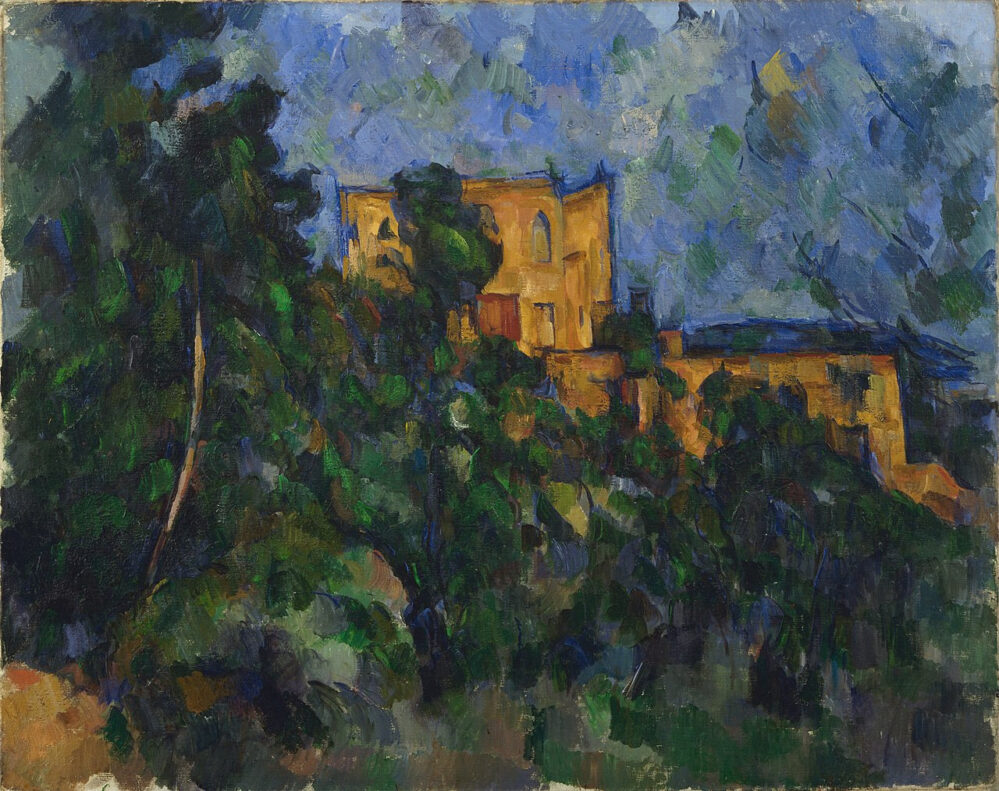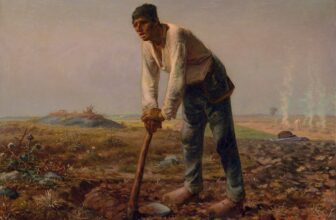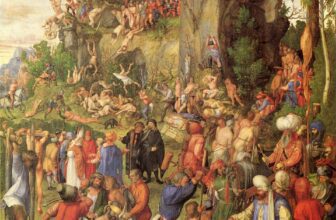
What is the Meaning of Paul Cézanne’s “Chateau Noir” Painting
Paul Cézanne’s Chateau Noir stands as one of the most haunting and enigmatic paintings of the Post-Impressionist era. Painted between 1890 and 1904, this work captures not just a physical landscape, but a psychological one. It represents the evolution of modern art and the pivotal transformation from Impressionism to Cubism. With its brooding atmosphere, distorted architecture, and expressive use of color, Chateau Noir is not merely a painting of a building in the French countryside, it is a symbol, a puzzle, and a vision.
In this in-depth exploration, we will delve into the meaning and symbolism behind Chateau Noir, examine the artistic techniques Cézanne employed, discuss the painting’s historical context, and discover where this masterpiece resides today. This story is not only about a painting; it’s about the birth of modern visual consciousness.
Paul Cézanne and the Birth of Modern Art
To understand Chateau Noir, one must first understand Paul Cézanne. Born in 1839 in Aix-en-Provence, Cézanne lived much of his life in the south of France. His work bridges the 19th and 20th centuries, laying the groundwork for future movements such as Cubism and abstract art. While initially influenced by the Impressionists, particularly Camille Pissarro, Cézanne ultimately diverged from their focus on fleeting light and movement.
Instead, Cézanne sought permanence in painting. He was obsessed with structure, form, and the geometric foundation of nature. His goal, as he famously stated, was “to make of Impressionism something solid and durable, like the art of the museums.” Chateau Noir is perhaps the clearest embodiment of this ambition.
The Real Chateau Noir: Setting and Subject
The real-life Chateau Noir was a decaying, gothic-style house located near Aix-en-Provence. Cézanne first encountered it in the 1890s during his walks around the countryside, often sketching and painting en plein air. He rented a studio nearby and visited the site frequently. The building, nestled within dense foliage and surrounded by rugged terrain, captured his imagination.
The Chateau itself was not grand in the traditional sense, it was brooding and mysterious, with an almost haunted quality. This atmosphere was precisely what appealed to Cézanne. He was drawn not to the grandeur of history, but to the psychological resonance of place. Chateau Noir thus represents a deeply personal and imaginative engagement with the world around him.
How Cézanne Painted Chateau Noir
Between 1890 and his death in 1906, Cézanne returned again and again to the motif of Chateau Noir, producing multiple paintings and sketches of it from different angles and in varying degrees of abstraction. The most famous version, now held at the Museum of Modern Art (MoMA) in New York, was painted around 1904.
Cézanne painted slowly and methodically. Unlike the Impressionists, who often completed their canvases in a single sitting to capture changing light, Cézanne worked over long periods. He would study a scene repeatedly, layering brushstrokes and building up structure piece by piece.
In Chateau Noir, this method results in a composition that feels carved rather than painted. The architecture is angular and distorted; the trees twist like figures in anguish. The brushwork is dense and textured, with every stroke contributing to the overall form. It is both representational and abstract, a tension that lies at the heart of its modernity.
What Is Happening in Chateau Noir?
On the surface, the painting is a landscape with a building partially obscured by dark foliage. But unlike typical landscape paintings that aim to please with serenity or harmony, Chateau Noir confronts the viewer with unease. The painting seems alive with psychological tension.
There are no human figures in the scene, and yet it feels inhabited, perhaps by memory, fear, or longing. The trees seem to move, the shadows deepen unnaturally, and the architecture appears to collapse and rise simultaneously. The atmosphere is heavy, almost gothic.
The “happening” in Chateau Noir is internal. It is Cézanne’s confrontation with nature and with himself. It is a moment of psychic reflection, less about depicting a place than about evoking a state of mind.
Symbolism and Meaning in Chateau Noir
The symbolism in Chateau Noir is rich and multilayered:
a. The Building as Psyche
Many art historians interpret the Chateau as a metaphor for the human mind. The darkened windows suggest emptiness or a gaze turned inward. The twisting trees and shifting planes mirror the subconscious processes of memory and imagination.
b. Nature vs. Architecture
Cézanne often explored the tension between man-made structures and organic nature. In Chateau Noir, the building seems to be swallowed by the landscape, suggesting either the triumph of nature or the fragility of human constructs. This theme resonates with broader modern anxieties about civilization and its discontents.
c. The Use of Color and Light
The palette is dominated by dark greens, browns, and ochres, lending the work its ominous tone. Light does not illuminate in the traditional sense, it is broken, filtered, scattered. This treatment of light and color symbolizes the fractured nature of perception itself.
d. Temporal Ambiguity
There is no clear time of day in the painting. It could be dusk or dawn, or a dream entirely outside of time. This ambiguity reinforces the painting’s symbolic role as an internal landscape rather than a literal depiction.
The Art Style of Chateau Noir
Chateau Noir is best categorized as Post-Impressionist, though it bears qualities that prefigure both Cubism and Expressionism.
Post-Impressionism is marked by a move away from the fleeting effects of light and atmosphere favored by the Impressionists. Instead, it emphasizes structure, symbolic content, and painterly experimentation.
Proto-Cubism is evident in the faceted treatment of form and the breakdown of perspective. Cézanne’s influence on artists like Picasso and Braque is profound, and works like Chateau Noir are a clear precursor to Cubist fragmentation.
Expressionism surfaces in the emotional intensity of the work. The dark palette, dramatic brushwork, and psychological depth point toward the Expressionist movement that would emerge in Germany in the early 20th century.
Thus, Chateau Noir is both of its time and ahead of it, a hinge between the 19th-century and the radical innovations of modern art.
Influence
Cézanne’s Chateau Noir had a tremendous impact on 20th-century artists. Picasso once referred to Cézanne as “the father of us all,” and paintings like Chateau Noir demonstrate why. In it, Cézanne breaks down the visual world into geometric forms and reassembles them according to a new logic, one governed not by external appearance but by inner truth.
For the Cubists, Chateau Noir represented a model of how to deconstruct the world. For the Expressionists, it showed how emotion could be embedded in landscape. For modern art as a whole, it was a turning point.
Where Is Chateau Noir Today?
The most famous version of Chateau Noir, painted around 1904, is part of the permanent collection at The Museum of Modern Art (MoMA) in New York City. This version was acquired in 1934 and has since become one of the museum’s most celebrated works.
Other versions and studies of Chateau Noir can be found in institutions such as:
The National Gallery of Art in Washington, D.C.
The Hermitage Museum in St. Petersburg
Private collections and various Cézanne retrospectives
Cézanne’s multiple engagements with the site mean that Chateau Noir exists in more than one form. Each version offers a slightly different perspective and emotional register.
Final Thoughts: The Mystery That Endures
Paul Cézanne’s Chateau Noir is a painting that resists easy interpretation. It is a landscape, but also a meditation. It is a building, but also a metaphor. It is haunted, not by ghosts, but by thought and memory.
More than a century after its creation, Chateau Noir continues to captivate viewers. It invites us into a shadowed world where the boundaries between inside and outside, nature and culture, reality and imagination dissolve. It is a painting to be studied, yes, but more importantly, it is a painting to be felt.
Key Takeaways
Artist: Paul Cézanne (1839–1906)
Title: Chateau Noir (c. 1904)
Location: Museum of Modern Art, New York
Style: Post-Impressionism; Proto-Cubist; Expressionist overtones
Symbolism: The psyche, nature vs. architecture, fractured perception
Meaning: Psychological landscape; reflection of Cézanne’s search for artistic truth
Legacy: Influenced Cubism, Expressionism, and 20th-century modernism
In Chateau Noir, Cézanne did not just paint a house on a hill. He painted the soul of modern art.




